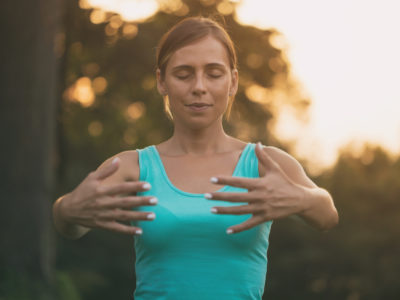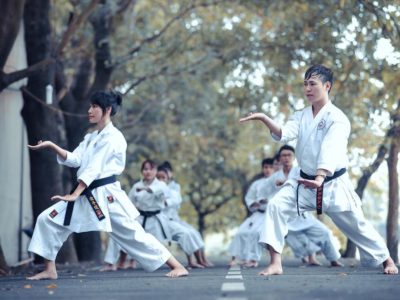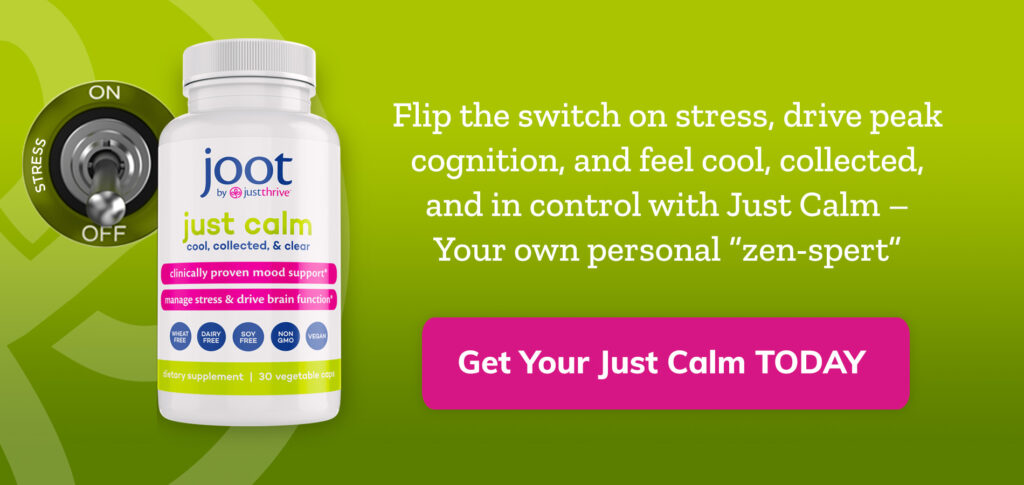Table of Contents[Hide][Show]
Qigong Exercises to Reduce Stress and Enhance Your Health and Well-Being+−
- 8 Benefits Of Zen Music For Stress Relief And Meditation (According To Experts)
- 1. Breathing Awareness
- 2. Willow Tree Qigong
- 3. Opening the Energy Gates
- 4. Shake or Bounce
- 5. Ride the Horse and Draw the Bow
- How to Practice Mindfulness
- 10 Best Herbs for Energy and Vitality
- Does Acupuncture Work? Everything You Need to Know About the Ancient Chinese Healing Art
What Is Qigong?
Before we proceed to the list of qigong exercises, let’s define the term. Let’s also explain the qigong vs tai chi difference.
Both qigong (pronounced chee gong) and tai chi are types of exercises from ancient China. They date back more than 1,500 years ago.
They can also be forms of martial arts, although they are not for combat. Most of all, they deal with an essential life component: chi (or qi).
Chi is life’s energy force. The flow of qi represents the invisible “liquid” or “river” that runs throughout the body, providing vitality.
When the body is sick, people believe there’s an imbalance in the chi or that something is blocking it. This idea comes from the basis of traditional Chinese medicine. Another fundamental Chinese theory is that of the yin and yang. The yin-yang theory states that everything in the universe is controlled by opposing, but connected forces. Yin represents the passive and yang represents the active.
From a medical perspective, the yin-yang theory helps explain imbalances in the body and how these can lead to dysfunction. It also provides guidance and methodology for the treatment of such imbalances and of disease.
One of the primary purposes of tai chi and qigong is to encourage the correct flow of chi throughout all the internal organs and meridians for the proper yin-yang balance.
Though there is overlap, the two practices also have distinct differences. For one, Tai Chi streamlines the energy within a person’s body, whereas Qigong cultivates energy and provides a method for using and distributing it.
There are also many different forms of qigong such as:
- Qigong meditation
- Medical qigong or healing qigong, which involves a qigong master transferring energy to the patient
- Sitting qigong
- Qigong yoga
- Qigong massage
In fact, for many, tai chi is a kind of qigong training. Regardless of their differences or similarities, one thing is clear: they have many health benefits.
Related
15 Types of Martial Arts and Their Health Benefits
What are the different types of martial arts and how will they benefit you? This article will tell you why you should consider learning martial arts! 15 Types of Martial Arts That Strengthen Your Body and Boost Your Brainpower For many folks, martial arts is an integral part of life. Students young and old choose …
3 Health Benefits of Qigong Exercises
Doing qigong exercises may help improve your health in the following ways:
1. Enhanced Immune System
If you’ve been more sickly than before, perhaps what you need is some gentle exercise. A 2003 research showed that even just one session of qigong training can boost your immune system.
To be specific, it can increase monocytes and lymphocytes. These are types of white blood cells.
Monocytes help fight against cancer cells and certain kinds of infections. Lymphocytes come from the bone marrow and have a variety of functions:
- Kill cancer cells and antigens
- Suppress immune overreaction to avoid an autoimmune disease
- Support other white blood cells
2. Decreased Anxiety and Depression
Qigong exercise may also improve your mental health by decreasing the symptoms of anxiety and depression, especially among those who are chronically ill. This is the finding of a 2013 meta-analysis in Evidence-Based Complementary and Alternative Medicine.
A possible reason is how it works with deep breathing and meditation. In fact, in qigong, every action is aligned with your breath.
A 2017 study revealed this type of breathing, sometimes called diaphragmatic breathing, can affect cortisol levels. Cortisol is a stress hormone that can increase heart rate and blood pressure.
3. Pain Relief
Both tai chi and qigong exercises can be excellent for those in pain, particularly joint or back pain. These are low-impact exercises, so the risks of injury are minimal.
Meanwhile, they help exercise the joints to keep them healthy and strong. This explains why they may be possible adjunct treatments for physical therapy.
Qigong Exercises to Reduce Stress and Enhance Your Health and Well-Being
These exercises are easy to follow and perfect for people just getting started, but they don’t represent all types of qigong. Should you want to improve your form or posture, you can always take qigong classes online and offline.
Still, they’re great exercises for beginners getting into the practice of qigong.
Related
8 Benefits Of Zen Music For Stress Relief And Meditation (According To Experts)
Do you want to improve your meditation techniques? How about lowering your stress levels? Then make listening to Zen music a habit! Read about all its benefits here.
1. Breathing Awareness
Breathing matters in qigong exercises. You have two options here: Buddha or Taoist. .
- In Taoist’s breath, you take as much air as you can while contracting your ab muscles. When you exhale, you relax the lungs and the upper body.
- In Buddha’s breath, you fill your abdomen with air, extending it, when inhaling. When you exhale, contract your ab muscles.
While doing your breathing exercise, perform the following:
- Stand straight with feet apart. Relax your knees and the rest of your body but tuck your chin.
- Open your palms to the side. As you breathe in, raise your palms and turn them over.
- Bring them down and sink your knees.
- Do these three times.
2. Willow Tree Qigong
This will serve as your warm-up, and you can do this for at least five minutes. It’s a simple swaying movement through your waist.
- Assume the starting position of the Taoist breathing exercise.
- Bend your knees and place your arms on the side.
- Using your waist, twist from left to right. Soften your arms and allow them to move freely as you twist.
- While you’re doing that, clear your mind from negative thoughts and invite peace and calm into your life.
- Take deep breaths in between twists.
3. Opening the Energy Gates
This is one of the qigong exercises that may benefit people with respiratory problems. These can include asthma and environmental allergies.
- Assume the starting position of Taoist breathing and willow tree qigong.
- Bring your palms at the center, facing each other. Raise them toward your chest level.
- Take a deep breath in slowly as you move your arms toward the side.
- As you breathe out, bring your palms together again while you bend your knees slightly.
4. Shake or Bounce
If you’re suffering from trauma, you may be feeling anger, depression, anxiety, and stress. You can use one of the qigong movements called shaking or bounce to help reduce these negative emotions.
- Assume the same starting position as the above exercises.
- Bring your heels up and take a deep breath. While you’re doing that, imagine all the “clutter” in your life you want to get rid of.
- Drop your heels hard to the ground and exhale. While you’re doing that, visualize you’re letting go of all these pent-up emotions.
- Start shaking by loosening your knees and moving your body up and down. Allow your hands and arms to move freely.
- Don’t forget to take deep breaths in between.
5. Ride the Horse and Draw the Bow
This is one of the trickiest qigong exercises for beginners since it involves many movements. You can never progress, though, unless you learn something intricate, right?
This one will help move more joints and increase your blood flow. By the end of this exercise alone, you should be more energetic or revitalized.
- Assume the same starting position as the exercises above.
- Step to the right in a wide stance. Bring both your arms around until they reach the top of your head. Inhale as you do so.
- Once they’re on top, close your palms into fists. Bring them to your right side as if you’re ready for a punch and exhale.
- Pull your left arm back until your arms appear as if it’s about to fire an arrow. Inhale.
- Drop down the arms and exhale.
- Repeat the process on the other side.
Final Thoughts
There are many beneficial mind-body effects of qigong. Like Tai Chi or Yoga, it’s a gentle form of physical exercise that still helps to keep every part of the body and mind healthy.
Qigong exercises make an excellent complement to your healthy lifestyle along with eating a healthy diet, drinking Alkaline Greens (use code WELL20 to save 20%), and supporting the strength of your gut with a daily probiotic supplement (our favorite is Just Thrive Probiotic).
They can awaken your body and mind, improve your focus, and lower your stress. This way, you’re more ready to deal with the challenges of the day.
Start adding qigong exercises to your daily routine for better overall health and quality of life – They’re almost as easy as breathing!
You May Also Like…
Editor’s Note: This post was originally published on August 30, 2019, and has been updated for quality and relevancy most recently on January 7, 2022.







